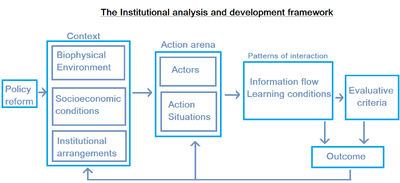Institutional analysis and development framework
The Institutional Analysis and Development framework (IAD) is a systematic method to collect policy analysis functions similar to analytic technique commonly used in physical and social sciences and understand the ways an institution can operate and change over a period of time.[1][2] It was developed by Elinor Ostrom, an American political scientist, also known as the first woman to receive the Nobel Memorial Prize in Economic Sciences in 2009.[3]

The Institutional Analysis and Development Framework views institutions as human-made system within which individual choices take place and which configure consequences of the respective choices.[1][4] According to Ostrom, IAD is a "multi-level conceptual map" with which one could zoom in and out of particular hierarchical parts of the regularised interactions in an established social system. It assumes a context to the particular interaction in which the general network of regular actors would be analysed, the particular rules-in-use, and the particular common outcome that they hope to achieve. In the traditional analysis of common pool arrangements, the common outcome would be a particular resource which the actors draw on.[5] IAD defines institutions as, "shared concepts used by humans in repetitive situations organized by rules, norms, and strategies".[6]
The IAD framework helps to perceive complex social phenomenon by dividing them into smaller pieces of practically understandable function.[1] The important aspect of IAD framework is that outcome is influenced by the institutional arrangements created by local actors in a given context.[7]
Charlotte Hess, noted researcher on common-pool resource,[8] said that the repositories at her academic institutions resembled commons in respects to the incentives for contributing information and the sharing of network capacity in the cases where information resource is in high demand.[9]
Before Ostrom died in 2012, she further elaborated the possible rules to analyze a particular action situation.[5]
| Rule type | Description |
|---|---|
| Position | The number of possible "positions" actors in the action situation can assume (in terms of formal positions these might be better described as job roles, while for informal positions these might rather be social roles of some capacity |
| Boundary | Characteristics participants must have in order to be able to access a particular position |
| Choice | The action capacity ascribed to a particular position |
| Aggregation | Any rules relating to how interactions between participants within the action situation accumulate to final outcomes (voting schemes etc.) |
| Information | The types and kinds of information and information channels available to participants in their respective positions |
| Pay-off | The likely rewards or punishments for participating in the action situation |
| Scope | Any criteria or requirements that exist for the final outcomes from the action situation |
References
- 1 2 3 Michael D. McGinnis. "An Introduction to IAD and the Language of the Ostrom Workshop: A Simple Guide to a Complex Framework for the Analysis of Institutions and Their Development". Indiana University. Retrieved 2 February 2015.
- ↑ Margaret M. Polski; Elinor Ostrom. An Institutional Framework for Policy Analysis and Design (PDF). Retrieved 1 February 2015.
- ↑ Ostrom, Elinor. (1990) Governing the Commons: The Evolution of Institutions for Collective Action. New York: Cambridge University.
- ↑ Charlotte Hess; Elinor Ostrom. "Ideas, Artifacts, and Facilities: Information as a Common-Pool Resource". Duke University School of Law. p. 22. Retrieved 30 January 2015.
- 1 2 Elinor Ostrom (2009). Understanding Institutional Diversity (PDF). Princeton: Princeton University Press. ISBN 9781400831739. Retrieved 30 January 2015.
- ↑ Xavier Basurto; Gordon Kingsley; Kelly McQueen; Mshadoni Smith; Christopher M. Weible. "A SYSTEMATIC APPROACH TO INSTITUTIONAL ANALYSIS: APPLYING CRAWFORD AND OSTROM'S GRAMMATICAL SYNTAX" (PDF). Indiana University. Retrieved 2 February 2015.
- ↑ Krister Andersson. "Understanding decentralized forest governance: an application of the institutional analysis and development framework". Sustainability: Science, Practice, & Policy. Retrieved 2 February 2015.
- ↑ "SelectedWorks of Charlotte Hess". Retrieved 1 February 2015.
- ↑ Charlotte Hess (May 1995). "The Virtual CPR: The Internet as a Local and Global Common Pool Resource" (PDF). Indiana University. pp. 5–6. Retrieved 30 January 2015.
Further reading
- Elinor Ostrom. "Institutional Analysis and Development: Elements of the Framework in Historical Perspective" (PDF). Retrieved 2 February 2015.
- Historical Developments and Theoretical Approaches in Sociology. Ramsey: Eolss Publishers. 2010. ISBN 9781848263321.